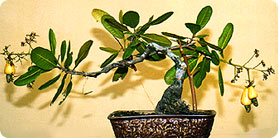 |
|
|
The art of Bonsai, together with the
Japanese flower arrangement, Ikebana, has been
originated in Japan and are now being admired throughout the
world. Among the lovers and admirers of Bonsai, there are many
who find an infinite pleasure in growing Bonsai - a
satisfaction of creating by their own hands the beauty of
nature in miniature.
Bonsai has as its prime object
the reproduction of the dignified beauty of an aged tree that
has survived centuries of exposure to the rigors and
relentless forces of nature and its environs. By reproduction
is meant also that a tree must be beautiful to look at - in
the formation of its branches, in the appearance of its
branches, in the appearance of its trunk and bark, the
development of the roots and the way in which the trunk grows
from the roots. It is the perspective of these various
features that manifest the power and vitality of nature as
well as the illusion of natural landscape. |
|
 |
|
|
It was the Chinese who first created the
miniature landscapes and trees that we now know as bonsai.
Called penjing by the Chinese, bonsai was believed to have had
its start in the Han Dynasty (206 B.C. - 220 A.D.) that an
emperor created a landscape in his courtyard complete with
hills, valleys, rivers, lakes and trees that represented his
entire empire.
Buddhist monks brought bonsai to the
island. For many years the art was practiced only by the
wealthy. It was with the Chinese invasion of Japan in the 14th
century that the art of bonsai started to be practiced by
people of all classes. Thus, bonsai began to grow in
popularity in Japan and outside the country.
Today,
bonsai are sold in department stores, garden centers,
nurseries, and many other places. Most trees purchased today
are known as pre-bonsai and are for the most part only used as
a starting point. To create a true bonsai work of art you need
to learn as much as possible about the art and the trees you
use. |



